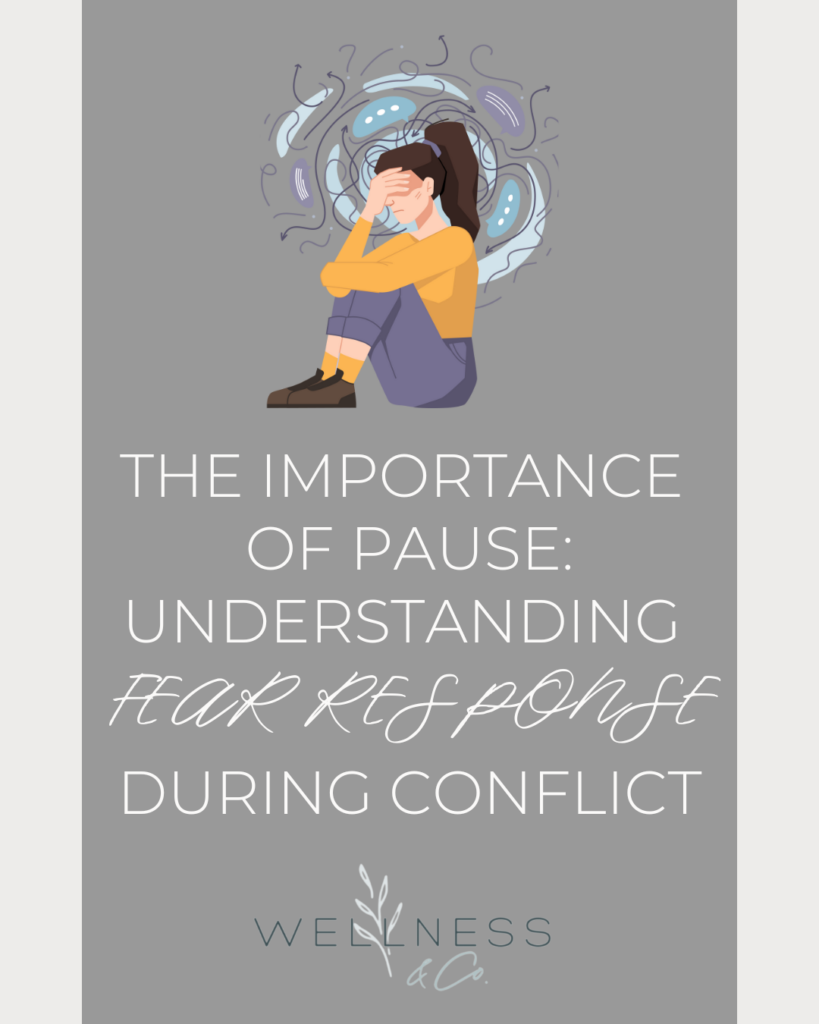Follow
Wellness & Co.
Hi, I'm Dr. K, Wellness & Co. is a growing therapy/coaching practice and educational hub for prospective clients based in Maryland and virtual clients all over the world!
Hi, I'm Dr. K
free guide
e -books
e -course
The Importance of Pause: Understanding Fear Response During Conflict
November 19, 2024
By: Ana Rogers, LGPC, NCC
READING TIME: 5 MINUTES

Hi friends! It’s been a while since we last chatted. I hope you’ve been taking good care of yourselves, especially with the fast approaching hustle and bustle of the holiday season.
And speaking of holidays, understanding more about how our brains operate when engaged in conflict might help inform when it’s time to take a breather and step away from the dinner table.
(Friendly reminder: it is also always okay to prioritize your peace and not attend family events if they are emotionally unsafe environments).
How our fear response manifests during relational conflict comes up frequently in the therapeutic space. Let’s be real – how could it not? As social beings, we all exist in the context of relationship in some way, whether it’s with family, friends, partners, or all of the above. And in even the healthiest of connections, experiencing disconnect and/or conflict is bound to happen.
Have you ever experienced regret or felt shame for something you did or said in a previous disagreement when things got heated? How about showing up in ways that don’t feel authentic to or congruent with who you typically know yourself to be? Maybe you’ve also learned that your partner or best friend has similar experiences when they’re feeling really big emotions. Most if not all of us have been there, myself included – yay common humanity! We’ll jump into a few of the reasons why these things happen in a moment.
Humans have evolved a lot. But our fear response continues to be quite primitive, doing everything it can to protect us from danger. And it doesn’t know the difference between a threat to connection and a threat to physical safety.
“But I’m not in any real danger” you might say. To which I respond, I hear you, AND our brains and bodies wholeheartedly believe we are. Emotional disconnect often feels and is unsafe in its own way. And that’s what our brain is responding to during conflict: a threat to relationship and connection with someone we love and by whom we want to be deeply known, understood, and loved in return.

So, what the heck is actually happening on a physiological level?
First, let’s quickly cover the two parts of our brain that are really important when it comes to our fear response: the prefrontal cortex (PFC) and the amygdala.
The PFC governs our critical thinking capabilities along with executive functioning like planning and organizing. It helps us make sense of our experiences and the world around us, and is also crucial in helping us emotionally regulate. The amygdala, though teeny tiny, also has a huge job. Its main goal is to protect us from and evade danger through processing emotions (like fear, rage, and anxiety) and identifying threats. When a threat is identified (and remember, emotional threats are treated identically to physical threats in our brains), that primal fear response, often referred to as fight, flight, freeze, or fawn, is triggered. In conflict, this might look like defensiveness and blaming (fight), abruptly leaving or even impulsively ending relationships (flight), withdrawal/stonewalling (freeze), and abandoning personal needs/boundaries to “keep peace” (fawn).
The biggest kicker here is that we lose access to our PFC when our fear response is activated. At this point, our brain’s primary goal is to protect us from the identified threat – the threat to connection – by any means necessary. Reasoning, logic, and emotion regulation become inaccessible and our main priority is self-preservation. Cue: acting out of character, saying things we don’t mean, and acting on impulses that we otherwise wouldn’t when we’re calm and thinking more clearly.
Try to visualize your amygdala as a snarling, barking guard dog who scares your wise owl (PFC) away when there is a threat. Without our wise owl present to help guide us, our guard dog acts without thinking. And we can harm our relationships in the process despite our guard dog’s well-intentioned efforts of self-protection.

This is why pausing and taking space is. so. important. Taking a breather helps us re-access our PFC and regulate our emotions. Our guard dog stops barking when we feel grounded and safe, and our wise owl can return, meaning that we can pursue reconnection and repair with our loved ones from a healthier headspace.
Tips for how to pause and take space during conflict:
- Explore what you notice about yourself when your fear response is activated. These are your signs to pause.
What is happening in your body? Your chest might be tight, your heart might be rapidly beating, or there might be a pit in your stomach. What are you noticing about your communication? Are there shifts in your volume or tone of voice? Maybe you’re noticing that your responses have moved from conveying care and concern to harsh criticism.
- Proactively agree on a safe word/phrase or physical gesture to use when you and your loved one notice communication is becoming unhelpful or harmful. This could simply be, “Pause.” A previously discussed hand gesture can also be helpful when verbalizing becomes difficult for those of us who shut down and withdraw.
- Find what helps you deescalate and regulate during the time you’re taking space. This might be a mindfulness technique like breathing or grounding. Maybe journaling, moving your body through some gentle stretches, or even watching a funny video, is what works for you.
It’s also helpful, especially for those of us who are more anxiously attached, to agree upon a set time to regroup, reconnect, and repair. For example, “I’m feeling really defensive and this isn’t how I want to show up for you or for us. I need to press pause, but let’s make sure we revisit tomorrow morning.”
Lastly, let this be a gentle reminder that this whole existing healthily in relationship thing is a lifelong journey. It’s not going to be perfect or even good some days. We can take accountability for how we show up for ourselves and others, commit to our own healing work, and give ourselves permission to try again tomorrow when today feels hard. And it’s all very much okay.
Looking for more individualized connection and support? Check out the amazing Wellness & Co. providers here and please be in touch!
Until next time,
Ana
Ana’s passion is providing a therapy space where you feel heard, seen, and valued. Whether you’re a couple looking to rebuild connection, a family seeking support in navigating life’s complexities together, or an individual wanting to heal and grow, she is here to walk alongside you!
Leave a Reply Cancel reply
CONTACT
Start Here
BLOG
OUR TEAM
SHOP
ABOUT
©2025 Wellness & Co. | All Rights Reserved | Design by EverMint Design Studio
BACK TO TOP
connect with us on instagram
